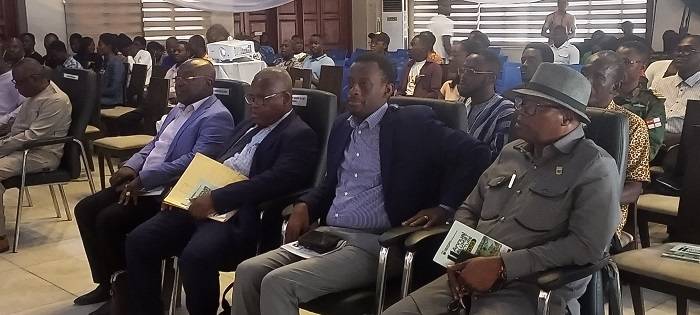Govt told to develop rail infrastructure, port to tap bauxite reserves

Mr Ayisi with Dr Kwesi Enyan, also an ALUMaT and Director and Mr Kwabena Okyere Darko-Mensah (second right) at the workshop
The Head of Technical Services, Rocksure International Limited, Mr Godfried Addo Ayisi, says suggested it is critical for Ghana to speed-up expansion of railway and ports infrastructure, as part of the Integrated Aluminium Industry (IAI) strategies to tap huge potentials of the country’s bauxite reserves.
He said “For IAI to be successful, there is the need to focus on port facilities and plan railway infrastructure development so that bauxite mines and alumina refineries can easily access them.
“This is critical. Ghana has bauxite resources of commercial quantities. The IAI vision for Government of Ghana is laudable and beneficial and in the interest of government will be protected better.”
Mr Ayisi made these arguments last week when he spoke on the “Overview of Ghana’ Integrated Aluminium Industry” at the 11th annual ALUMaT lecture (2023) at UMaT School of Railways and Infrastructure Development (SRID).
He told the audience that the strategic master plan for the IAI mentioned the improvement of the 326 km western rail line to facilitate transportation and the expansion of the Takoradi Port to facilitate bauxite ore and alumna export.
Mr Ayisi, said the 37-kilometer Takoradi-Manso project funded by the government and executed by Amani had been completed whiles the 77km Manso -Huni Valley line funded by Deutshebank and executed by Amandi was, in progress.
However, the 212km Huni- Valley Nyinahin line to be executed by TheloDB was currently undergoing feasibility studies, but no source of funding secured yet, the lecturer said.
The extension of the gas pipeline through Nyinahin to Kumasi for the provision of adequate power for IAI, he added, was another plank of the strategy.
The 1987 ALuMaT group member stated that, Ghana’s Integrated Aluminium Development Corporation (GIADEC’s) vision for the downstream, was anchored by VALCO smelter to drive the utilisation of locally produced aluminium in Ghana and beyond.
Refinery alone, Mr Ayisi explained, would require the production of caustic soda, made from salt, adding “This is a whole industry by itself.”
He continued “It is clear that government idea of IAI to mine bauxite, refine bauxite into alumna, smelt it into aluminium and use it to produce downstream products will be very beneficial to the development of Ghana.”
Mr Ayisi proposed Ghana mined its bauxite and add value locally to tap huge capital outflows into the economy, arguing that the resources were of high quality with the potentials to drive development, create jobs, and also transform value chain within the mining industry.
Ghana’s total bauxite resource excluding the 814 Metric tonnes from Ejuanema, was 2,112 Mt, and that, assuming 80 percent conversion of the reserve was used at the price of $45.93 per tonne, the country’s total was value at $77.6 billion.
Ghana’s bauxite deposits, Mr Ayisi said, were located within forest reserves, as for example, Awaso was located within the Afao Hills forest reserve, Nyinahin-Mpasaso deposits located within the Tano Offin reserves.
With this, he suggested the use of a surface miner to protect the fauna and flora, using best practices of mining and environmental protection like reclamation and revegetation.
The Western Regional Minister, Kwabena Okyere Darko-Mensah, also recognised the potentials of the aluminium industry to diversify the economy and reduce Ghana’s reliance on traditional exports like cocoa and gold.
From Clement Adzei Boye, Essikado












